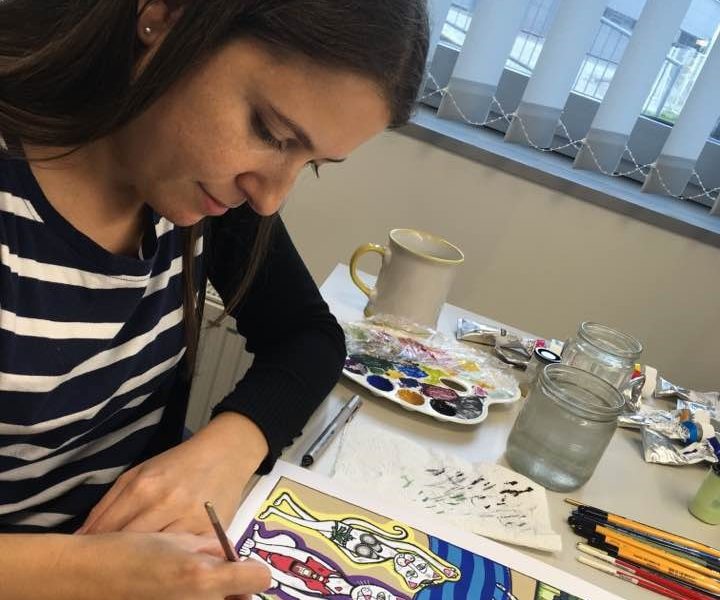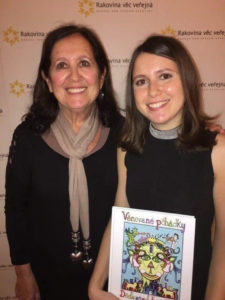Featured Item
The inspiring legacy of Carolyn Gad, art’s magical fairy

Carolyn Gad had attracted international attention, been invited to be artist-in-residence at a prestigious medical institute, and illustrated a book to raise funds for cancer research all by her early 30s.
She did it all before contracting cancer herself. It was such a rare form of the disease, that only seven people in the world were diagnosed with it. “Each one of them would wear a t-shirt printed with an illustration by Carolyn. And one by one, they passed away,” says her mother, Millicent.
“A talented artist, she lived her dream,” says her father, David. The Cape Town couple, who have three elder sons, laid their only daughter to rest in December 2020. She was 37 years old. Her parents have since made peace with her passing. But when they read of the recent death of young Hanna Green, also from a rare form of cancer, they reached out to her parents to offer support and comfort in the face of such senseless loss.

Carolyn’s art developed into a distinct, whimsical, and playful style that’s instantly recognisable. It all began at a young age, when her drawing was selected to be printed on a t-shirt for her Jewish pre-primary school in Cape Town. Millicent is also an artist. After Carolyn passed away, her mother painstakingly made a mosaic of Carolyn’s own illustration, titled Flower Girl, to cover the grave. People from far and wide stop to admire the magnificent image created by a young woman gone too soon and by a mother who had to bury her own child.
Carolyn had perivascular epithelioid cell neoplasms. These are rare soft-tissue tumours, often formed around small blood vessels. “It wasn’t genetic – just bad luck,” says Millicent. “Although when she was diagnosed, the doctor asked if she was an Ashkenazi Jew. Apparently such rare cancers are often found in Ashkenazi Jews because we’re so intermarried.”
Carolyn matriculated from United Herzlia Schools in 2001. Writing in the schools’ alumni publication in 2017, she said, “Shortly after I matriculated, I completed a BTech degree in textile and surface design at CPUT [the Cape Peninsula University of Technology]. After graduating in 2005, I spent time travelling and working before accepting a once-in-a-lifetime opportunity to work in a relatively unknown town called Olomouc, a quaint university town in the Czech Republic.
“During my stay, I held the position of invited artist at the Institute of Molecular and Translational Medicine in Palacký University’s biomedical research department. It’s the only university in the world that employed an artist-in-residence for its medical research programme. My role centred on bringing science to the public through art, and I was mainly tasked with creating illustrations for talks about medical research given by the institute’s director as he would speak to the public at conferences around Europe.
“A while back, the institute’s non-profit organisation approached me to illustrate a book titled Dedicated Fairy Tales for the purpose of raising funds for cancer research. Ten well-known Czech and Slovak personalities had written the stories. The launch was a momentous and proudly South African moment for me as I earned international recognition as an illustrator. Dedicated Fairy Tales has been well received and exposed widely in the media.”
Her parents say she was incredibly brave in moving to the Czech Republic, taking such a unique opportunity while knowing no one. This bravery would continue as she battled with cancer. Carolyn fell in love with her new home, which in turn seemed to fall in love with her. She was warmly welcomed and made friends wherever she went. Her art can be found in the Czech Republic, Germany, Poland, France, Slovakia, the United Kingdom, United States, South Africa, and Australia. She chose to have much of her medical treatment in the Czech Republic. “The public hospitals were top class – on par with medical care in America or Israel,” says her father.
But disaster struck when doctors discovered the extent of her cancer. “They told her that she had just two to three weeks to live,” says David. Twenty minutes after she received that news, another life changing announcement came through: she was invited to exhibit at the Jewish museum in Prague, with the work being viewed by 7 000 people a day. But in light of her diagnosis, she had to turn it down – a heartbreaking decision. She also had to leave the Czech Republic, where she felt she truly belonged. Her parents took her home, and she lived for another 16 months. They buried her at the height of the pandemic.
Carolyn would explore her illness through her art. Her last image posted on her Instagram account, titled The Butcher, depicts a doctor doing an operation. Though it’s in her bright and playful style, the painting is harrowing. Other images show her tumours as frightening faces, but some pictures are more light-hearted. Self portrait with Epithelioid Angiomyolipoma is colourful and almost joyful. She even depicted herself having surgery in an illustration that’s peaceful and startling.
Now, her legacy continues. Her parents recently bestowed a generous annual award to the University of Cape Town’s Michaelis School of Fine Art. “Carolyn was a driven person who had so many dreams about her career and future, we wanted to leave a legacy in her name to continue for many years. We felt the prize should be shared to give two people the opportunity of winning. It will be given to the top student in practical and the top student in theory.”
In her piece for the Herzlia alumni publication, Carolyn described her motivation and process. “I want to remind people of the importance of using imagination – a powerful tool, which, unfortunately, many of us are suppressing by immersing ourselves in technology. My inspiration arises almost entirely from my imagination. I play around with elements extracted from doodles to create new and unique compositions. My illustrations mostly depict fantasy worlds and the whimsical characters that exist within them. Unlike most illustrators today, I prefer to create by hand instead of on a computer. My preferred medium is gouache [a water-soluble pigment] watercolour, and fine liner pen on watercolour paper.
“We tend to grow up believing that we should stick to one particular course in life and follow in the footsteps of those before us,” she said. “I believe that there’s no specific recipe for each of us to adhere to in life, and we shouldn’t feel pressured into following the crowd but rather design our own lives by striving towards our dreams and desires.
“My advice to anyone wishing to pursue a career in the arts is to spend less time immersed in technology and preserve your imagination,” she wrote. “It’s difficult to be original these days, but always be yourself. Don’t be intimidated or discouraged by the enormous pool of talent out there because someone may be better than you on a technical level, but there’s only one you and nobody can express your story as creatively as you can. So go out there, and tell your story.”
Monty Goldin
June 23, 2022 at 2:02 pm
What a sensitive, intelligent and creative human being Carolyn was. May her memory be a blessing. I wish her family a long life.
David might remember me. I was a friend of his brother Louis.
Cynthia Barmor
June 24, 2022 at 8:17 am
What a beautiful, sad, yet true account of Carolyn’s unusual and original artistic talent. She was a gentle person with an engaging smile which lit up her eyes, like her mother’s. I was privileged to know her and of her through my life-long friendship with Milli and David Gad. May the legacy of her creativity live on forever, and may she rest in peace. The thoughtful gift made by Milli and David to the Michaelis Art Faculty is a fitting tribute to Carolyn’s memory.